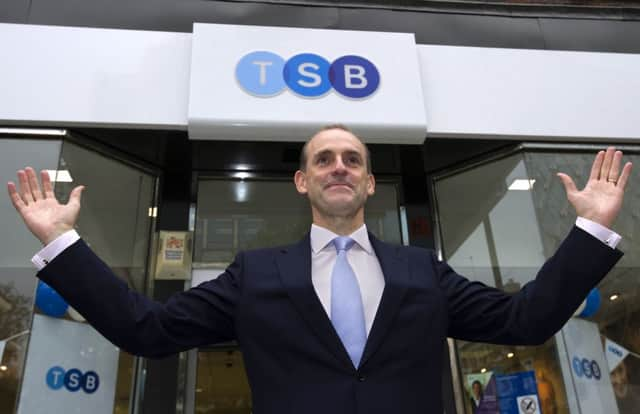TSB warns of Scottish independence risk


It also said it would spend £250 million over the next five years on developing products, expanding its branch network and boosting its 8,600-strong workforce.
In a 332-page prospectus published today, TSB said 27 per cent of its customers are north of the Border and “the outcome of the referendum could contribute to prolonged uncertainty around certain aspects of the Scottish economy, Scottish companies and UK consumers’ confidence in businesses with significant operations in Scotland”.
Advertisement
Hide AdAdvertisement
Hide AdThe lender also cautioned that a decline in house prices could have a “material adverse effect” on its business due to its exposure to the mortgage market.
Shares in the bank, being sold by Lloyds to meet European state aid rules, will be priced 220p and 290p, giving it a mid-point valuation of almost £1.3 billion – below its £1.6bn book value.
Amid concerns that the City’s appetite for new listings is waning, Cenkos Securities analyst Sandy Chen said he expects the shares to debut towards the bottom end of the range when trading starts on 20 June. He said: “After all, TSB is merely the new badge on the old ‘Project Verde’ that the Co-op and NBNK had valued at circa £700m.”
The Co-op had agreed to pay £750m for the 631 branches being sold by Lloyds, but a black hole in the mutual’s finances saw the deal collapse last year.
However, insiders stressed that TSB, which saw its pre-tax profits jump 72 per cent to £67m last year, has “high growth potential” and the shares have been priced to reflect its prospects, although it does not plan to start paying a dividend until 2018. TSB has a 4.2 per cent share of the current account market and wants to grow that to 6 per cent over the next four to five years to match its share of the UK’s branch network.
Chief executive Paul Pester is embarking on a two-week roadshow to pitch the flotation at institutional shareholders. Small shareholders will get one free share for every 20 they buy up to the value of £2,000 – as long as they hold them for a year after the float.
Pester said: “Uniquely positioned with the mindset of a challenger, but with the capabilities of a major high street bank, we believe that TSB is the only challenger bank able to provide, with scale, a genuinely different alternative for consumers.”
Lloyds, which also owns Bank of Scotland and Halifax, is being forced to sell TSB as a condition of receiving a UK government bail-out during the financial crisis, and must sell the remaining 75 per cent by the end of next year.
Advertisement
Hide AdAdvertisement
Hide AdThis year has witnessed a rash of flotations, dominated by the retail sector, but fashion chain Fat Face last month blamed “current equity market conditions” after pulling its planned IPO, and shares in over-50s insurance and holidays specialist Saga have fallen below their issue price.
Specialist lender One Savings Bank last week priced its shares at the bottom of their expected range when it floated at 170p.
However, they have since risen in value and challenger bank Shawbrook is considering a flotation next year after delivering its first annual pre-tax profit since it was launched in 2011.